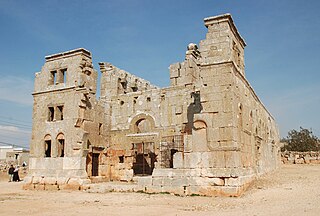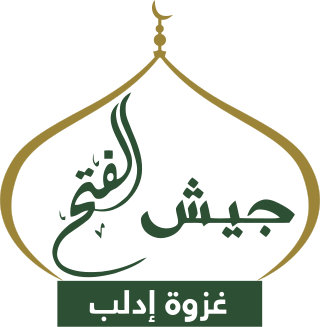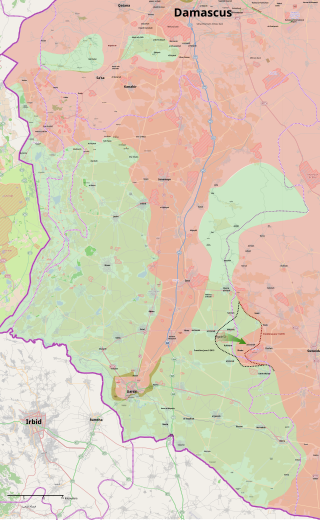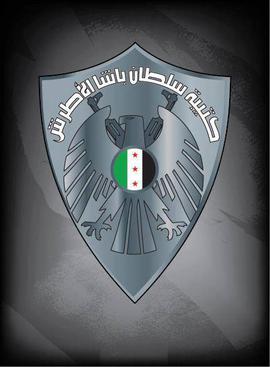
Walid Kamal Jumblatt is a Lebanese Druze politician and former militia commander who has been leading the Progressive Socialist Party since 1977. While leading the Lebanese National Resistance Front and allying with the Amal Movement during the Lebanese Civil War, he worked closely with Suleiman Frangieh to oppose Amine Gemayel's rule as president in 1983. After the civil war, he initially supported Syria but later led an anti-Assad stance during the start of the Syrian Civil War. He is still active in politics, most recently leading his party, the Progressive Socialist Party (PSP) in the 2022 Lebanese general election.

Qalb Loze is a Druze village in northwestern Syria, administratively part of the Idlib Governorate located about 35 kilometres (22 mi) west of Aleppo. It is situated near the border with Turkey, in the A'la Mountain and is part of an area known as the "Dead Cities". According to the Syria Central Bureau of Statistics (CBS), Qalb Loze had a population of 1,290 in the 2004 census.

The Syrian Civil War is an intensely sectarian war. After the early years of cross-sectarian opposition to the rule of Bashar al-Assad, the civil war has largely transformed into a conflict between ruling minority Alawite government and allied Shi'a governments such as Iran; pitted against the country's Sunni Muslim majority who are aligned with the Syrian opposition and its Turkish and Persian Gulf state backers. Sunni Muslims make up the majority of the Syrian Arab Army (SAA) and many hold high governmental positions, while Alawites and members of almost every minority have also been active on the rebel side. Despite this, Sunni recruits face systematic discrimination in the armed forces and ninety percentage of the officer corps are dominated by Alawite members vetted by the regime; based on their sectarian loyalty to Assad dynasty. SAA also pursues a truculant anti-religious policy within its ranks; marked by animosity towards Sunni religious expressions such as regular observance of salah (prayers), Hijab (headcoverings), abstinence from alcoholic drinks, etc.

Al-Nusra Front or Jabhat al-Nusra, known as Jabhat Fatah al-Sham after July 2016, and also described as al-Qaeda in Syria or al-Qaeda in the Levant, was a Salafist jihadist terrorist organization fighting against Syrian government forces in the Syrian Civil War. Its aim was to establish an Islamic state in the country. The group has changed its name several times and merged with and separated from other groups.
The 2012–2014 Quneitra Governorate clashes began in early November 2012, when the Syrian Army began engaging with rebels in several towns and villages of the Quneitra Governorate. The clashes quickly intensified and spilled into the UN-supervised neutral demilitarized zone between Syrian controlled territory and the Israeli-occupied Golan Heights.
The Lebanese–Syrian border clashes were a series of clashes on the Lebanon–Syria border caused by the ongoing Syrian Civil War.
The Adra massacre was the killing of at least 32 Alawite, Christian, Druze and Ismailite civilians in the industrial town of Adra, Syria in December 2013, during the Syrian Civil War. According to the government and activists it was conducted by the al-Nusra Front. The U.S. State Department condemned massacres in Syria and condemned 'the latest report of a massacre of civilians in Adra.'

The spillover of the Syrian Civil War is the impact of the Syrian Civil War in the Arab world and beyond. Since the first protests during the Arab Spring, the increasingly violent Syrian Civil War has been both a proxy war for the major Middle Eastern powers, Turkey and Iran, and a potential launching point for a wider regional war. Fears of the latter were realized when the Islamic State of Iraq and the Levant (ISIL), a Salafi Jihadist militant group and alleged former al-Qaeda affiliate, established itself in Syria in 2013, and later combined with the War in Iraq (2013–2017) into a single conflict the following year. The spillover of the Syrian Civil War is often dubbed the Arab Winter.
The following is a timeline of the Syrian civil war from August to December 2014. Information about aggregated casualty counts is found at Casualties of the Syrian Civil War.
The Deir ez-Zor offensive was executed by the Islamic State of Iraq and the Levant, also known as ISIS, against all other opposition forces in the Deir ez-Zor Governorate as part of the Inter-rebel conflict during the Syrian Civil War.

The Battle of Idlib was a military operation in the Idlib Governorate, during the Syrian Civil War, conducted by rebels against Syrian government forces defending Idlib city.

The Army of Conquest or Jaish al-Fatah, abbreviated JaF, was a joint command center of Sunni Islamist Syrian rebel factions participating in the Syrian Civil War.

The Qalamoun offensive was an offensive led by the Iranian-backed militia Hezbollah, supported by the Syrian Army, during the Syrian Civil War, against the al-Nusra Front and other Syrian opposition forces entrenched in the mountains of the Qalamoun region.

The Daraa and As-Suwayda offensive was launched in eastern Daraa Governorate during the Syrian Civil War, by the Southern Front of the Free Syrian Army and allied Islamic Front rebel group against government positions in and around the 52nd Mechanized Brigade base, which housed an infantry unit, an artillery battalion and a T-72 tank battalion. The offensive moved directly onto nearby al-Thula airbase in western As-Suwayda Governorate after the swift capture of Brigade 52. However, after initially managing to capture parts of the airbase, the rebels were forced to withdraw.
The Quneitra offensive was launched by Syrian rebel forces, during the Syrian Civil War, in order to capture the last government-held positions in Quneitra Governorate: Hader, Madinat al-Baath, Khan Arnabah and the strategic hill of Tell Krum. The other objective was connecting southern rebel-held parts of Syria with Western Ghouta.
Druze in Syria is a significant minority religion. According to The World Factbook, Druze make up about 3.2 percent of the population of Syria, or approximately 700,000 persons, including residents of the Golan Heights. The Druzites are concentrated in the rural, mountainous areas east and south of Damascus in the area known officially as the Jabal al-Druze.
The following is a timeline of the Syrian Civil War from January to July 2015. Information about aggregated casualty counts is found at Casualties of the Syrian Civil War.

The Sultan Pasha al-Atrash Battalion was an armed Syrian rebel group affiliated with the Free Syrian Army that operated in southern Syria during the first 3 years of the Syrian Civil War. The group consisted of rebels from the Druze community in Syria, particularly in the Suwayda Governorate. The group disbanded in the beginning of 2014 after frequent attacks on it by Sunni Islamist groups, particularly al-Qaeda's al-Nusra Front.
Opposition–ISIL conflict during the Syrian Civil War started after fighting erupted between Syrian opposition groups and the Islamic State of Iraq and the Levant (ISIL). In early January 2014, serious clashes between the groups erupted in the north of the country. Opposition groups near Aleppo attacked ISIL in two areas, Atarib and Anadan, which were both strongholds of the fundamentalist Sunni organization. Despite the conflict between ISIL and other rebels, one faction of ISIL has cooperated with the al-Nusra Front and the Green Battalion to combat Hezbollah in the Battle of Qalamoun. By 2018, the Islamic State was destroyed in the territories held by the opposition.











